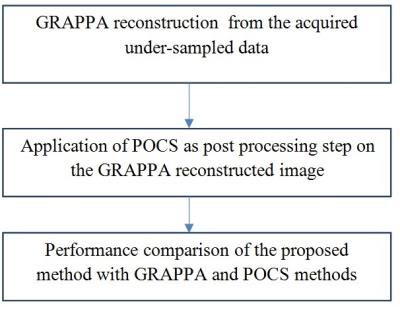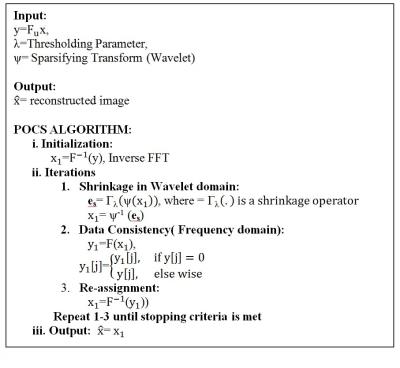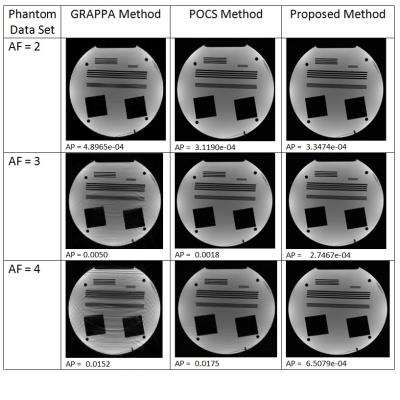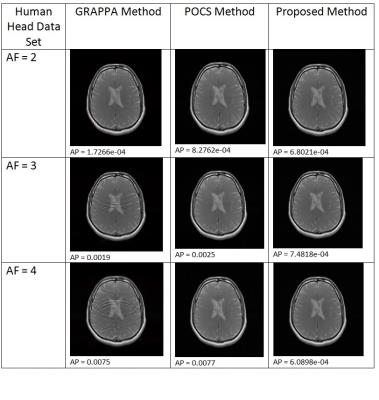5175
Combined Application of GRAPPA and POCS for Fast MR Image Reconstruction1Electrical Engineering, COMSATS Institute Of IT, Rawalpindi, Pakistan, 2National Center for Physics, Islamabad, Pakistan, 3COMSATS Institute Of IT, Islamabad, Pakistan
Synopsis
The proposed work presents a combination of GRAPPA and Compressed sensing (POCS) to reconstruct MR images from the highly under-sampled data. Firstly, GRAPPA is applied to the acquired under-sampled data. The output of GRAPPA which contains aliasing artifacts (especially for high acceleration factors) is fed in to POCS which solves for the solution image iteratively and produces a reconstructed image with minimal aliasing artifacts. The reconstruction results are compared with GRAPPA and POCS separately. The results show that the proposed method significantly reduces the aliasing artifacts as compared to GRAPPA or POCS reconstructions.
Purpose
GRAPPA1 is a PMRI algorithm that results in severe artifacts for high Acceleration Factors (AF). POCS2,3 is a non-linear reconstruction algorithm used in Compressed Sensing (CS) which also has limitations for high AF. To improve the reconstructed image quality for high AF, this research proposes a combined application of GRAPPA and POCS. The results obtained from the proposed method are compared with GRAPPA reconstructions and with POCS reconstructions separately. The results demonstrate that the proposed method significantly improves the reconstructed image quality as compared to GRAPPA or POCS reconstructions.Methods:
PMRI uses the receiver coil sensitivity information to reconstruct MR images from the under-sampled data. CS-MRI2 conventionally uses non-linear conjugate gradient (NLCG) method to reconstruct MR image from the under-sampled data. However there are other non-linear methods available which could be used to reconstruct the image in CS-MRI such as POCS2, 3. POCS algorithm performs the image reconstruction iteratively3 and is computationally less intensive as compared to NLCG.
Combining PMRI and CS algorithms to get synergic output is an exciting area of research4,5. Ying4 et al combined CS with Cartesian SENSE and demonstrated the effectiveness of their method (CS-SENSE). Shahzad et al5 combined CG-SENSE with CS to obtain better reconstructed image quality at higher AF.
In this paper, Cartesian GRAPPA and POCS are combined to reconstruct MR image from highly under-sampled data. The main steps of this work are shown in Figure 1. The proposed method takes the under-sampled k-space data as an input and applies Cartesian GRAPPA to reconstruct the MR image. It is proposed to apply POCS algorithm on the GRAPPA output image to perform the de-noising operation. Figure 2 shows the main steps of POCS algorithm. In this work, thresholding parameter "λ" is selected heuristically to 0.025, Wavelet Transform is used as a sparsifying transform and the no. of iterations is selected heuristically to 40 iterations for all the reconstructions. After initialization, the proposed method iteratively performs shrinkage in Wavelet domain (Soft thresholding is used as a shrinkage operator) and data consistency in Frequency domain. The iterations are repeated until stopping criteria is met and final output image is produced with minimal artifacts. The results show that for AF=2, there are no significant artifacts present in the GRAPPA or POCS reconstructed image, while in case of higher AF, significant noise-like aliasing artifacts are present in the reconstructed images from GRAPPA or POCS, which de-grades the reconstructed image quality.
Phantom and Human Head data sets were acquired at St. Mary’s hospital London using 1.5T GE scanner obtained with eight channel head coil array with the following specifications: Size=256x256x8, TE=10msec, TR=500msec, FOV=20cm, Bandwidth=31.25KHz, Slice Thickness=3mm and Flip Angle=50°. In this work, the acquired 8 coil fully sampled Cartesian MRI k-space data is retrospectively under-sampled for different AF i.e. 2, 3 and 4. The number of ACS lines is limited to 32 in all the simulations.
All the reconstructions are performed using MATLAB R2013a on core I7 CPU with 2.7 GHz clock speed and 8 GB RAM.
Artifact power6 (AP) is used as a quantifying parameter to measure the reconstructed image quality of the reconstructed images.
Results and Discussion
Figure 3 and Figure 4 show the reconstructed images of Phantom and Human Head Data sets from GRAPPA, POCS and the proposed method. AP values are mentioned at the bottom of the reconstructed images in Figure 2 and 3.
Table 1 summarizes the AP values of the reconstructed images from both datasets. For AF=2, the AP values of the reconstructed images from GRAPPA, POCS and the proposed method are close to zero which demonstrates good reconstruction. However in case of AF=3, the AP values of the Phantom and Human Head data for GRAPPA reconstructions are 0.0050 and 0.0019 respectively. For POCS reconstructions the AP values are 0.0018 and 0.0025 respectively, and by using the proposed method the AP values are 2.7467e-04 and 7.4818e-04 respectively which clearly shows the improvement in the reconstructed image quality by using the proposed method. Similarly for AF=4, GRAPPA reconstructed images have AP values 0.0152 and 0.0075 for Phantom and Human Head datasets respectively, for POCS method the AP values are 0.0175 and 0.0077 respectively, and by using the proposed method AP values are 6.5079e-04 and 6.0898e-04 respectively. The results demonstrate that there is significant improvement in the reconstructed image quality by using the proposed method.
Conclusion
A combined application of GRAPPA and POCS is presented. The results show a considerable improvement in the quality of the reconstructed images by using the proposed method as compared to GRAPPA or POCS method.Acknowledgements
We like to thank COMSATS Institute of IT to provide the necessary resources for this work.References
[1] Griswold, M., et al. Generalized auto-calibrating partially parallel acquisitions (GRAPPA).Magnetic resonance in medicine. 2002;47(6): 1202-1210.
[2] Lustig, M., et al. Sparse MRI: The application of compressed sensing for rapid MR imaging. Magnetic resonance in medicine. 2007; 58(6): 1182-1195.
[3] Shah, J. et al. A modified POCS-based reconstruction method for compressively sampled MR imaging. International Journal of Imaging Systems and Technology. 2014; 24(3): 203-207.
[4] Liang, Dong, et al. Accelerating SENSE using compressed sensing. Magnetic Resonance in Medicine 2009; 62(6): 1574-1584.
[5] Shahzad, H. et al. Combined Application of PMRI and CS for MR Image Reconstruction. Annual meeting of European Society for Magnetic Resonance in Medicine and Biology (ESMRMB), Vienna 2016. [6]Omer, H et al. A graphical generalized implementation of SENSE reconstruction using Matlab. Concepts in Magnetic Resonance Part A. 2010; 36(3): 178-186.
Figures




